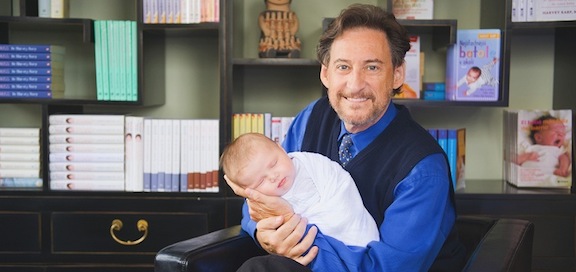All children cry, this is a normal part of development. Some parents may endure their baby’s long cry, but some may not put up with this. The crying of the child inevitably affects you and makes you tense and restless, signals you that something is wrong with your baby. These feelings are completely normal.

The main reasons for crying:
- From hunger;
- Wet diaper / diaper;
- Uncomfortable or uncomfortable in the diaper / clothes;
- The child is hot or cold;
- Colic or gaziki (stomachache), constipation;
- Diaper rash;
- Teeth are cut;
- The child is just tired.
A detailed article on the causes of the crying baby: why is the baby crying (and how to understand the reasons)
How to calm a baby 0 - 3 months. Harvey Carp Method
Harvey Karp, a twenty-year-old pediatrician, associate professor of pediatrics at the Southern California Medical Institute. The author of two books: “The happiest baby in the quarter: How to stop the crying of a newborn” and “New parenting: without tears and conflicts” Developed a 5-step methodology to calm a crying baby.

Harvey Karp's method is based on the child's unconditioned reflexes. The essence of the theory (and active practice) is that the best sedation for the baby is to create conditions reminiscent of the time when he grew up in his mother’s tummy.
- Swaddling. It is necessary to swaddle the baby tightly so that the child does not move his arms. Why? The uterus was quite cramped, but comfortable and safe. Swaddling can create similar conditions. (If you swaddle weakly, the baby will be swaddled again and will scream).
- Side position. The position of the baby on your side or stomach on your hands. Kids should sleep on their backs, but they calm down best on their side or stomach. Face a little down. You will need to find the position in which your baby calms down. You can put it on your stomach on your hand. Dads are especially fond of it. See for yourself: it is worth turning the crying baby on its side or on its stomach, it calms down.
- White noise or “boo”. Have you noticed that many newborns sleep better under the measured buzz of household appliances or the hiss of the radio? Try to bring the crying baby to a working range hood. Surely he will stop crying. White noise imitates the sound of mom’s heart. You need to “bark” or “hiss” loudly. As loud as he cries. If you yourself are passionate about something, you may not hear the phone ring. So are the children. You need to bark enough, leaning towards their ear, and reduce the noise level as the baby calms down.
- Motion sickness baby. Rhythmic wiggle.Motion sickness can be different. Shaking back and forth does not give the desired sensations. You should use the technique of “shaking the baby’s head in its open palm.” Put the baby on your hands, face down, so that its head rests on your palm. And start swinging. This is the sensation he experienced in the womb. So you can swing the baby at least all day without harming him. The newborn relaxes and feels comfortable. For those who are afraid to swing, so as not to be accustomed to the hands, we recall that the child swayed throughout the pregnancy in his stomach. And since, in fact, the newborn is not yet a child, but rather a “fetus,” he cannot be spoiled.
- Sucking.Last but not least. Breastfeeding is one of the most effective ways to calm a newborn. If the baby has chosen a position on his stomach, you can put your finger in your mouth, satisfying the sucking reflex.
According to the experience of Harvey Karp himself, sometimes it’s enough to apply one or two tricks from this list so that the child stops crying and worries. But often you have to use all five methods in sequence. According to the doctor, these simple methods, together or separately, help in almost 100 percent of cases.
More tips
The works of the pediatrician T. Berry Brazelton describe various causes of crying in infants. As already mentioned at the beginning of the article, crying can cause pain, hunger, boredom, colic, various inconveniences. Also, the child cries at the end of the day to relieve stress. If you don’t know what makes him hysterical, then start eliminating these reasons one after another. At the same time, try not to panic, stay calm. If you worry, the child will feel it and will cry even more. The following are tips to complement Harvey Karp's method.
- Make sure all your child’s needs are met: the diaper is dry, it is not too hot or too cold, it is comfortable in your crib and so on.
- Speak softly or sing to your baby, turn on soft music. Your presence and voice can be soothing.
- Pull to yourself, the proximity of the parent reassures.
- Talk to the baby. Let him know that you are close and will come soon. Sometimes a child simply does not have a feeling of mother's warmth. You can put a breast pad soaked with your milk on it, take it with you to bed, let it hear your mother’s heart beat.
- If there is no obvious reason for crying, try giving the baby some water. If he is hungry, he will refuse it. Then you should give him a meal. If crying continues during feeding, then the baby may have irritation on the mucous membrane. Or the middle ear is inflamed.
- Try to give your baby a light massage. This will help calm him and help you relax, as well as strengthen the bonds between you and your baby. (See how to massage).
- Check if teeth are cut. At the same time, the saliva flows in the child, and he bites his fingers. And you will need to clean his gums with clean hands. Also try anointing them with a special ointment, which is available in pharmacies.
- Make the atmosphere comfortable. Sometimes a baby can just get tired of how many things surround him. Take away all the toys from him for a while, make the room softer lighting. He may also be uncomfortable in the diaper, in this position, clothing. In the end, his diaper could overflow.
- Touch the nape of the baby. The skin in this area should not be too cool or too warm. In the first case, put on extra clothes. In the second - measure the temperature, undress and after half an hour again check the temperature.
- Help get rid of colic. Press the legs to the tummy, do exercises “bicycle”. You can also put the child on your lap, laying a pre-warm diaper, carry it on your palm with your tummy, with your head on the bend of your hand. Sometimes, instead of a warm diaper, a bag of flax seeds is used that better holds heat. Massage your tummy clockwise.A vent tube will help to free the baby's intestines from gases. (See detailed tips on How to help your baby with colic).
- Provide tactile contact. Put the undressed baby on your bare belly. Give him a massage. Touch the back, legs, arms, tummy. Play the magpie.
- Bathe in a warm bath. It relaxes the child, relieves anxiety. It also sometimes helps if you just wipe his face with cool water.
- Go out with him for a walk. It’s good if you wear it in sling. This combines three points from Harvey Karp's methods: swaddling, rocking and the “white noise” of the street. You can also ride it in the car.
- Help let the air out. During crying, the baby swallows a lot of excess air. This brings additional discomfort. Therefore, you need to pick it up and hold it in an upright position so that it can burp. Do not forget that this should be done after each feeding.
- Move together while dancing. Smooth movements, your calm speech, swaying and his favorite uncomplicated melody can produce a positive effect. After the dance, hold it to you, give some water, a dummy.
- Bring your child’s attention to other objects. A number of tips and discoveries of parents is based on switching the attention of the baby. In addition to general methods, each mother can have her own "key" to the calmness of the baby. It can be a noisy toy that emits vibrations, for example, a musical carousel.
Below is a list of these “keys” from different parents. Perhaps one of them is right for you:
- Take the child and bring it to the window, then to another, thus showing different pictures. Show off image cards.
- Read your favorite poems.
- Speak with your child in different tones. Describe aloud your every action.
- Show him objects of different colors, sizes, shapes. First, right in front of him, then drive from side to side.
- Open the tap with water. The sound of water can play the role of "white noise."
- Clatter with keys or something else ringing.
- Blow it on your forehead.
- Put fragrant bags with chamomile, mint, sandalwood next to it.
- Let him hold them one at a time. You can also make the bags different to the touch, filling them with the following contents: cereals, sand, decorative pebbles.
- Try to circle with the child, holding him in his arms.
- Let the other relatives pick up the baby.
- Hang spinning toys over his crib.
- Use a projector lamp to captivate your child with the illuminated images on the walls.
- Show him houseplants.
- Let the baby look at his reflection in the mirror.

Folk wisdom can also come to the rescue if you trust its advice. Firstly, in the old days it was forbidden to talk about misfortunes with an unhealthy child. Secondly, it was impossible to call him bad words, scolding. All that was allowed was to sing. According to psychologists, these tips are not unfounded. In such a critical state of hysteria, the baby will perceive every word very painfully, fix it in the subconscious. And this can cause trouble in adulthood. Therefore, try to restrain your emotions. Although this is difficult, you should remember that you can influence the future of your child.
On this topic: 10 tips to stop yelling at your children
There is also a folk remedy for the evil eye: three times pass a palm over the face of the baby, washing it with cool water. Speak the following words: “Like water from a goose, like water from a swan, so thin from (name of a child) - thinness”.
It must be remembered that such calming methods can often distract the child from negative emotions only for a while. For a deeper understanding of the issue, it is recommended to read Aleta Salter's book, What to Do When a Baby Cries?
It should be understood that everything is individual. Different tricks can be effective depending on the situation and time. You know your child better than anyone.Take the baby in your arms more often, and not just when it cries. Do not worry that you can spoil the baby. It will not happen. On the contrary, if you react only to crying, your baby will quickly understand this and will cry constantly to attract your attention.
Read on:
- 9 more tips to calm a crying baby
- How to quickly calm a newborn baby when he cries, hysteria, is naughty
- The vagaries of a small child: how to respond?
- What if I constantly scream at the child?
Video consultation









In addition to eliminating all the possible causes of crying - hunger, wet diapers, colic, illness, and so on, I can say from my own experience that transferring the child to other hands very often helps, I don’t know why it works and often enough, maybe the changing energy of another family member helps.
Our daughter did not grow up a very restless child, but at the age of four months she mixed up day and night, now we are tormented! During the day, at least somehow slept, with interruptions, but at night at no time. Cried, worried. No motion sickness helped. We got out of the situation by breastfeeding (although a significant overfeeding was obtained). And distraction also helped a lot, it came to the point that they asked for a neighbor's cat for rent :) - he is quiet and affectionate, his daughter calmed down with him immediately.